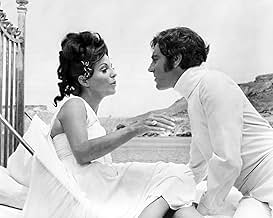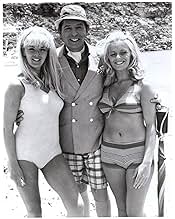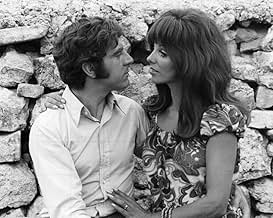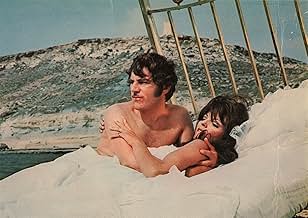Die Gelüste des Hieronymus
Originaltitel: Can Heironymus Merkin Ever Forget Mercy Humppe and Find True Happiness?
IMDb-BEWERTUNG
4,9/10
433
IHRE BEWERTUNG
Füge eine Handlung in deiner Sprache hinzuHeironymus Merkin screens an autobiographical movie of his life, growth, and moral decay.Heironymus Merkin screens an autobiographical movie of his life, growth, and moral decay.Heironymus Merkin screens an autobiographical movie of his life, growth, and moral decay.
- Regie
- Drehbuch
- Hauptbesetzung
- Auszeichnungen
- 1 wins total
Tara Newley Arkle
- Thumbelina
- (as Tara Newley)
Empfohlene Bewertungen
With a long title and confusing plot, "Can Hieronymus Merkin Ever Forget Mercy Humppe and Find True Happiness?" left me befuddled. Portraying an entertainer (Anthony Newley) recounting his life story as a series of short films, the whole movie feels like something drifting aimlessly in water. It seems like a giant ego project. I'm still trying to figure out what the movie's overall point was.
Since I found this on what appeared to be a pirated video, I suspect that no one saw fit to formally release this movie on video (or DVD). Like one of Newley's later, equally confusing movies ("It Seemed Like a Good Idea at the Time", notable for an early appearance of John Candy), it's not terrible but seems to have no point whatsoever. You probably don't want to make it your first choice. I have to admit that I'd never heard of Anthony Newley until he died.
Also starring Joan Collins, Milton Berle, Connie Kreski and Stubby Kaye (Marvin Acme in "Who Framed Roger Rabbit").
Since I found this on what appeared to be a pirated video, I suspect that no one saw fit to formally release this movie on video (or DVD). Like one of Newley's later, equally confusing movies ("It Seemed Like a Good Idea at the Time", notable for an early appearance of John Candy), it's not terrible but seems to have no point whatsoever. You probably don't want to make it your first choice. I have to admit that I'd never heard of Anthony Newley until he died.
Also starring Joan Collins, Milton Berle, Connie Kreski and Stubby Kaye (Marvin Acme in "Who Framed Roger Rabbit").
The title alone was enough to kill it dead in the water but if you got past that and made it into the few cinemas that showed it then the first ten minutes might have finished you off but this hugely self-indulgent picture is actually worth sticking around for. Okay, the gags are terrible and Newley, who directed it, co-wrote it, composed the music and plays the lead is no Orson Welles but there is a surfeit of imagination at work here and presuming it is mostly autobiographical, (his wife, Joan Collins, and children play his wife and children), few artists, and Newley surely is that, have ever been so self-critical in public; it's as if he wants us to hate him.
Fellini, of course, is the most obvious object of his affections, (he even gets a name-check), which probably riled the critics the most. How dare he think he could remake "8 1/2" and as a musical comedy, they probably screamed, and needless to say the film was not just a gigantic flop, both critically and commercially, but often figures in lists of the worst films ever made. It's certainly not always an easy watch; like a traffic accident it's very hard to look at what's happened yet impossible to look away. It's also impossible to ignore.
Fellini, of course, is the most obvious object of his affections, (he even gets a name-check), which probably riled the critics the most. How dare he think he could remake "8 1/2" and as a musical comedy, they probably screamed, and needless to say the film was not just a gigantic flop, both critically and commercially, but often figures in lists of the worst films ever made. It's certainly not always an easy watch; like a traffic accident it's very hard to look at what's happened yet impossible to look away. It's also impossible to ignore.
Little seen ego-trip for the resistible talents of writer/producer/director/composer/star Anthony Newley (featuring his then-wife Joan Collins) which, due to its copious and gratuitous nudity (including its creator!), is surely the most notorious production ever to be filmed in Malta and, consequently, something of a holy grail for local film buffs! Given its unavailability, then, I wasn't overly disappointed in the poor (but certainly not unwatchable) quality of the print and the film itself, possessing a certain sense of style, wasn't as worthless as its reputation would have it!
In itself, a flashy and pretentious semi-autobiographical piece obviously inspired by Fellini's 8½ (1963), it's largely set on a beach where the protagonist is apparently mounting a film based on his own life (how self-indulgent can you get?). In fact, what plot there is resolves itself into a music-hall revue with plenty of rather quaint musical numbers (one of which is reprised ad nauseam throughout) by Newley and others. These, however, are often interrupted by the surprising presence of legendary American showmen George Jessel (as a wise-cracking, white-clad Angel Of Death figure, dubbed "The Presence") and Milton Berle as the Mephistophelean Goodtime Eddie Filth.
Newley's choice of character names is, if anything, admirably Fieldsan: indeed, here, Heironymus Merkin is torn between Collins' Polyester Poontang and Playboy playmate Connie Kreski's Mercy Humppe (hence the film's unwieldy title). Occasionally, too, Merkin is able to step out of character in order to observe his own actions enacted, in the interim, by a blank-faced dummy! Also incorporated is an irrelevant adult-oriented fairy-tale, entitled "The Princess And The Donkey", involving the intimate relationship between one Trampolena Whambang and a mule (which then turns into a dwarf!); amazingly, this infamous sequence was filmed in Malta's Presidential Palace!! The cast includes other familiar faces such as Stubby Kaye as Merkin's long-suffering scriptwriter and Victor Spinetti as a bewildered film critic who, perhaps justly, blames Fellini for Merkin's (and, by extension, Newley's) folie de grandeur.
There's a possible goof, too, in the appearance of a religious statue in the background during one of the beach sequences; this was supposedly removed for filming purposes and, consequently, has been the cause of much consternation locally to this day! I'm also confused by the film's actual running time: the X-rated version I watched, which one would assume to be uncut, ran for 107 mins. (with the trimmed R-rated version being 106 mins. long) but the BBFC gives its complete length as 117 mins.!
In itself, a flashy and pretentious semi-autobiographical piece obviously inspired by Fellini's 8½ (1963), it's largely set on a beach where the protagonist is apparently mounting a film based on his own life (how self-indulgent can you get?). In fact, what plot there is resolves itself into a music-hall revue with plenty of rather quaint musical numbers (one of which is reprised ad nauseam throughout) by Newley and others. These, however, are often interrupted by the surprising presence of legendary American showmen George Jessel (as a wise-cracking, white-clad Angel Of Death figure, dubbed "The Presence") and Milton Berle as the Mephistophelean Goodtime Eddie Filth.
Newley's choice of character names is, if anything, admirably Fieldsan: indeed, here, Heironymus Merkin is torn between Collins' Polyester Poontang and Playboy playmate Connie Kreski's Mercy Humppe (hence the film's unwieldy title). Occasionally, too, Merkin is able to step out of character in order to observe his own actions enacted, in the interim, by a blank-faced dummy! Also incorporated is an irrelevant adult-oriented fairy-tale, entitled "The Princess And The Donkey", involving the intimate relationship between one Trampolena Whambang and a mule (which then turns into a dwarf!); amazingly, this infamous sequence was filmed in Malta's Presidential Palace!! The cast includes other familiar faces such as Stubby Kaye as Merkin's long-suffering scriptwriter and Victor Spinetti as a bewildered film critic who, perhaps justly, blames Fellini for Merkin's (and, by extension, Newley's) folie de grandeur.
There's a possible goof, too, in the appearance of a religious statue in the background during one of the beach sequences; this was supposedly removed for filming purposes and, consequently, has been the cause of much consternation locally to this day! I'm also confused by the film's actual running time: the X-rated version I watched, which one would assume to be uncut, ran for 107 mins. (with the trimmed R-rated version being 106 mins. long) but the BBFC gives its complete length as 117 mins.!
As a performer (musical or otherwise), Anthony Newley has always been an acquired taste. His cabaret-born stylings and exaggerated delivery (again, while singing or acting) can either be interpreted as heartfelt or preening. Newley had done nothing on the screen up to this point to justify the jaded, indifferent, Felliniesque "Heironymus Merkin", an autobiographical jumble of vaudeville skits, sex and songs. Newley directed and has the lead; he also co-wrote the script with Herman Raucher, scored the music and produced. Obviously, this project meant a lot to him, but it was shunned upon its release (the ungainly title was most likely no help). The film gives off bad vibrations, as well as the puzzling impression it was made by somebody who hoped to get out of show business. A musical-comedy star reflects on his life upon turning 40 (the age, Merkin tells us, when men's bodies begin to decay); he's guided along his journey by George Jessel (dressed in all-white) and Milton Berle (dressed in suit jackets and shorts, like a leering carnival barker). Newley cavorts with a bevy of women (a handful of whom were featured in a nude Playboy layout, which figured in the advertising), but Merkin/Newley views sex cheerlessly. The women are sex objects to be ogled and then cheated on--until they get pregnant, which leads to the ultimate trap: marriage. While Newley is anxious to show off the bare breasts of his actresses (minus those of wife Joan Collins, who is turned into a shrew), he stops short of celebrating their bodies; in Newley's world, a sex scene is included only to showcase his prowess as a ladies' man. He's not only the star of his own movie, he's the leading man in each of his lovers' movies (the ladies have no personalities--only lascivious names). This self-adoration is probably the reason the film was taken to task by the critics, who called it a megalomaniacal disaster. Is it truly wretched? I would say Newley adopts a certain style from the Masters, which is unfortunately hindered in the end by the lenient editing. There are far too many shots of Newley with his shirt off, or with his shoes off, allowing the camera to admire him. He primps, he sticks out his bottom lip and looks boyish, he dresses as a life-size marionette and collapses, hoping to grab our hearts. The picture isn't a personal triumph because it has been shaped and styled to reveal Anthony Newley as a sad puppet, a crying clown, and the image is so false that nobody--least of all of Newley--could get away with it. *1/2 from ****
People complain that studios don't take chances anymore. Well, although sometimes when they did take a chance they made a masterpiece, they also came up with movies like this! This movie is a mess, so...weird. For much of the running time, it's fascinating to watch its insanity, though eventually it becomes tiring. The only really funny bit is the hilariously tasteless "The Princess and the Donkey" number.
Wusstest du schon
- WissenswertesWhen this movie was originally released in 1969, some newspapers refused to advertise it, compelling cinephiles to call up their local theaters to learn the title. A few theaters even temporarily expanded their marquees to fit the entire title. Other theaters truncated the title to "Heironymous Merkin".
- PatzerThe color of Thumbelina's ice-cream cone changes between brown and white and pink.
- Zitate
Hieronymous Merkin: Then the Eskimo and the Indian and the cannibal all rush over to the knight and they say, "Your dragon was here and he's looking to terrify you a great deal." And the knight sits there, and he laughs, and he laughs, and he laughs. The moral of the story is, once you understand your own dragon, you don't have to be afraid anymore. See what I mean?
- Crazy CreditsThere are no opening credits. All credits come at the end. The actors take a bow on a custom-made, pastel-painted, portable stage on a beach as their names are credited in jagged, psychedelic print.
- Alternative VersionenThere is both an R-rated and an X-rated version. The R-rated version removes a few seconds of the sex scene with Mercy Humppe following the carousel sequence and tones down the suggestiveness of the "Princess and the Donkey" sequence. The X-rated version contains all the footage cut for the R version.
- VerbindungenFeatured in Ich bin Joan Collins! (2022)
- SoundtracksPiccadilly Lilly
(uncredited)
Performed by Anthony Newley and Bruce Forsyth
Music by Anthony Newley
Lyrics by Herbert Kretzmer
Top-Auswahl
Melde dich zum Bewerten an und greife auf die Watchlist für personalisierte Empfehlungen zu.
Details
- Erscheinungsdatum
- Herkunftsland
- Sprache
- Auch bekannt als
- .... Can Heironymus Merkin Ever Forget Mercy Humppe and Find True Happiness?
- Drehorte
- Malta(beach scenes)
- Produktionsfirmen
- Weitere beteiligte Unternehmen bei IMDbPro anzeigen
- Laufzeit1 Stunde 47 Minuten
Zu dieser Seite beitragen
Bearbeitung vorschlagen oder fehlenden Inhalt hinzufügen

Oberste Lücke
By what name was Die Gelüste des Hieronymus (1969) officially released in Canada in English?
Antwort

































